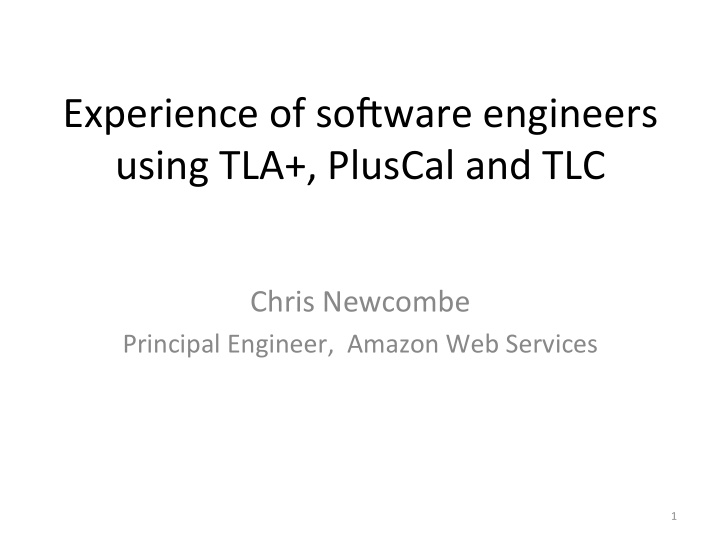



Experience ¡of ¡so-ware ¡engineers ¡ using ¡TLA+, ¡PlusCal ¡and ¡TLC ¡ Chris ¡Newcombe ¡ Principal ¡Engineer, ¡ ¡Amazon ¡Web ¡Services ¡ 1 ¡
Amazon ¡Web ¡Services ¡ • 30+ ¡services ¡ [1] ; ¡compute, ¡storage, ¡db, ¡queuing, ¡… ¡ • High ¡Scale: ¡ – S3 ¡(Simple ¡Storage ¡Service) ¡launched ¡in ¡2006 ¡ now ¡holds ¡over ¡1 ¡trillion ¡objects ¡ growing ¡by ¡3.5 ¡billion ¡per ¡day ¡ [2] ¡ • SophisVcated ¡features ¡ – DynamoDB: ¡strongly-‑consistent, ¡highly ¡available, ¡ scalable, ¡predictable ¡performance, ¡mulV-‑tenant ¡ • “NetFlix ¡is ¡now ¡100% ¡cloud” ¡(on ¡AWS) [3] ¡ 2 ¡
Most ¡services ¡face ¡the ¡same ¡problem ¡ Interac(ng ¡ subtle ¡algorithms ¡ – complex ¡business ¡logic, ¡rules-‑engines, ¡evolving ¡ schemas, ¡… ¡ – interacVons ¡with ¡other ¡systems ¡ – dynamic ¡group-‑membership; ¡ ¡live ¡re-‑sharding ¡/ ¡auto-‑ scaling ¡ – concurrency-‑control ¡ – consistency, ¡workflow ¡ – replicaVon, ¡fail-‑over ¡ – acVons ¡by ¡human ¡operators ¡ 3 ¡
Why ¡don’t ¡engineers ¡specify ¡their ¡ systems? ¡ • Deep ¡ignorance/confusion ¡about ¡benefit, ¡terminology, ¡ method, ¡tools ¡ • Deep ¡skepVcism ¡of ¡snake-‑oil ¡ ¡“The ¡weight ¡of ¡evidence ¡for ¡an ¡extraordinary ¡claim ¡must ¡be ¡ propor(oned ¡to ¡its ¡strangeness.” ¡-‑ ¡Laplace ¡ • No ¡Vme ¡to ¡look ¡at ¡anything ¡that ¡is ¡not ¡an ¡immediate ¡ producVvity ¡gain ¡ ¡ • Failing ¡to ¡disVnguish ¡design ¡flaw ¡vs. ¡implementaVon ¡bug ¡ • Skills ¡complacence ¡: ¡‘I ¡only ¡need ¡java/python/…’ ¡ • ResignaVon ¡: ¡‘Bugs ¡are ¡inevitable ¡anyway…’ ¡ • “Blog-‑comment ¡culture” ¡-‑ ¡more ¡fun ¡to ¡broadcast/defend ¡ an ¡immediate ¡personal ¡opinion ¡than ¡to ¡consider ¡changing ¡it ¡ 4 ¡
Moving ¡from ¡‘intuiVve ¡correctness’ ¡to ¡precision ¡ From ¡ “Java ¡Concurrency ¡In ¡Prac(ce” , ¡page ¡17 ¡ ¡ ¡ ¡ ¡ ¡“Correctness ¡means ¡a ¡class ¡ conforms ¡to ¡its ¡specifica(on . ¡A ¡good ¡ specificaVon ¡defines ¡ invariants ¡ constraining ¡an ¡objects ¡state, ¡and ¡ postcondi(ons ¡ describing ¡the ¡effects ¡of ¡its ¡operaVons. ¡ ¡ ¡ ¡ ¡ ¡ ¡Since ¡we ¡o-en ¡don’t ¡write ¡adequate ¡specificaVons ¡for ¡our ¡classes, ¡how ¡can ¡ we ¡possibly ¡know ¡they ¡are ¡correct? ¡We ¡can’t, ¡but ¡that ¡doesn’t ¡stop ¡us ¡from ¡ using ¡them ¡anyway, ¡once ¡we’ve ¡convinced ¡ourselves ¡that ¡“the ¡code ¡works”. ¡ ¡ ¡ ¡ ¡ ¡ ¡This ¡“code ¡confidence” ¡is ¡about ¡as ¡close ¡as ¡many ¡of ¡us ¡get ¡to ¡correctness, ¡ so ¡ let’s ¡just ¡assume ¡that ¡single-‑threaded ¡correctness ¡is ¡ something ¡that ¡“we ¡know ¡it ¡when ¡we ¡see ¡it” . ¡ ¡Having ¡ opVmisVcally ¡defined ¡correctness ¡as ¡something ¡that ¡can ¡be ¡ recognized, ¡we ¡can ¡now ¡define ¡thread ¡safety…” ¡ 5 ¡
Terminology ¡difficulVes ¡ • Allergic ¡to ¡the ¡word ¡“formal” ¡ • Overloaded ¡terminology: ¡ ¡ ¡ “So, ¡‘specificaVon’ ¡means ¡inputs ¡and ¡outputs, ¡right?” ¡ • Current ¡best ¡soluVon: ¡ ¡call ¡it ¡ “ExhausVvely-‑testable ¡pseudo-‑code” ¡ 6 ¡
The ¡most ¡persuasive ¡example ¡so ¡far ¡ 7 ¡
A ¡famous ¡system ¡design ¡ ¡(2001) ¡ 8 ¡
Ring ¡of ¡nodes ¡ “Three ¡features ¡that ¡dis(nguish ¡Chord ¡from ¡many ¡other ¡peer-‑to-‑peer ¡ lookup ¡protocols ¡are ¡its ¡simplicity, ¡ provable ¡correctness, ¡ and ¡ provable ¡performance.” ¡ 9 ¡
Original ¡pseudo-‑code ¡for ¡Chord ¡ 10 ¡
Nine ¡years ¡later, ¡another ¡paper ¡… ¡ 11 ¡
Found ¡ 8 ¡major ¡defects ¡in ¡the ¡ ¡ Chord ¡ring-‑membership ¡protocol ¡ 12 ¡
13 ¡
IniVal ¡conceptual ¡difficulVes ¡ ¡ when ¡engineers ¡are ¡learning ¡TLA+ ¡ • Single ¡global ¡state ¡-‑-‑ ¡“But ¡where ¡is ¡the ¡concurrency?” ¡ • Use ¡of ¡non-‑determinism ¡ • Interleaving ¡vs. ¡non-‑interleaving ¡specificaVon ¡ – “Can ¡‘either ¡… ¡or ¡…’ ¡allow ¡2 ¡or ¡more ¡clauses ¡to ¡happen?” ¡ • Unfamiliar ¡kinds ¡of ¡expressions ¡ ¡ – ‘programming’ ¡via ¡recursive ¡operators, ¡ ¡ instead ¡of ¡using ¡set ¡comprehensions ¡ • Idioms? ¡ ¡E.g. ¡for ¡abstracVng ¡network ¡ • “What ¡is ¡the ¡difference ¡between ¡ ¡[ ¡-‑> ¡] ¡and ¡[ ¡|-‑> ¡] ¡?” ¡ • AcVons ¡that ¡inadvertently ¡access ¡the ¡state ¡of ¡other ¡ processes ¡(e.g. ¡to ¡get ¡data ¡that ¡should ¡have ¡been ¡sent ¡as ¡ part ¡of ¡a ¡message ¡payload) ¡ 14 ¡
More ¡advanced ¡conceptual ¡difficulVes ¡ • Liveness ¡is ¡a ¡property ¡of ¡an ¡infinite ¡behavior, ¡ so ¡what ¡does ¡TLC’s ¡“liveness ¡checking” ¡ actually ¡tell ¡you? ¡ • How ¡can ¡we ¡easily ¡tell ¡if ¡it ¡safe ¡to ¡use ¡a ¡ symmetry ¡set ¡for ¡model-‑checking? ¡ 15 ¡
SuggesVons ¡to ¡help ¡increase ¡adopVon ¡ • Syntax ¡highlighVng ¡for ¡PlusCal ¡ • A ¡wiki-‑style ¡cookbook ¡of ¡specificaVon ¡idioms ¡ ¡ ¡ • A ¡wiki-‑style ¡cookbook ¡of ¡tricks ¡for ¡using ¡TLC ¡ • More ¡real-‑world ¡example ¡specificaVons ¡ and, ¡ideally, ¡their ¡inducVve ¡invariants. ¡ ¡ ¡ 16 ¡
Use ¡at ¡Amazon ¡so ¡far ¡ 1. “Tim” ¡Fault-‑tolerant ¡replicaVon ¡ ¡ ¡ ¡(interacVng ¡distributed ¡algorithms) ¡ 2. “Fan” ¡Fault-‑tolerant ¡network ¡protocol ¡ 3. “Mike” ¡Lock-‑free ¡data ¡structure ¡ 4. “Chris” ¡Concurrent ¡algorithm, ¡ ¡ ¡ ¡ ¡involving ¡third-‑party ¡components ¡ 5. “Sam” ¡Fault-‑tolerant ¡replicaVon ¡ ¡ ¡(interacVng ¡distributed ¡algorithms) ¡ 6. “Cahill” ¡IsolaVon ¡of ¡database ¡transacVons ¡ 17 ¡
“Tim” ¡ interacVng ¡distributed ¡algorithms ¡ • Fault-‑tolerant ¡replicaVon, ¡group-‑membership ¡ • Principal ¡Engineer, ¡one ¡of ¡the ¡best ¡at ¡Amazon ¡ • Algorithm ¡was ¡already ¡designed, ¡and ¡coded ¡in ¡java, ¡with ¡months ¡of ¡ thorough ¡design ¡analysis ¡(30+ ¡pages ¡of ¡informal ¡prose ¡proofs) ¡ • Approx. ¡6 ¡weeks, ¡while ¡doing ¡other ¡work ¡ • Pure ¡TLA+. ¡ ¡ ¡We ¡might ¡have ¡considered ¡PlusCal, ¡but ¡hadn’t ¡tried ¡it ¡ yet. ¡ ¡Not ¡sure ¡how ¡PlusCal ¡works ¡with ¡mulVple ¡modules. ¡ • 939 ¡non-‑comment, ¡non-‑blank ¡lines ¡split ¡across ¡7 ¡modules ¡ • 529 ¡pure ¡comment ¡lines ¡ • 11 ¡invariants. ¡ ¡ ¡No ¡liveness ¡properVes. ¡ • Distributed ¡TLC, ¡on ¡cluster ¡of ¡10 ¡“cc1.4xl” ¡nodes ¡in ¡EC2 ¡ • TLC ¡found ¡3 ¡important ¡bugs . ¡ ¡Counter-‑examples ¡had ¡35+ ¡steps. ¡ 18 ¡
Recommend
More recommend